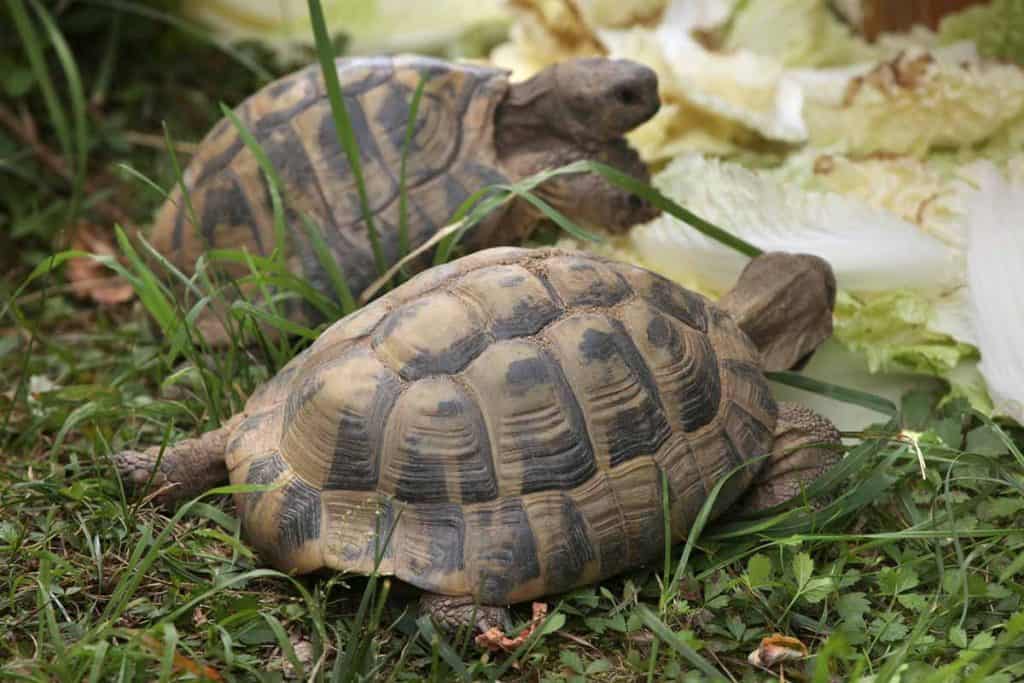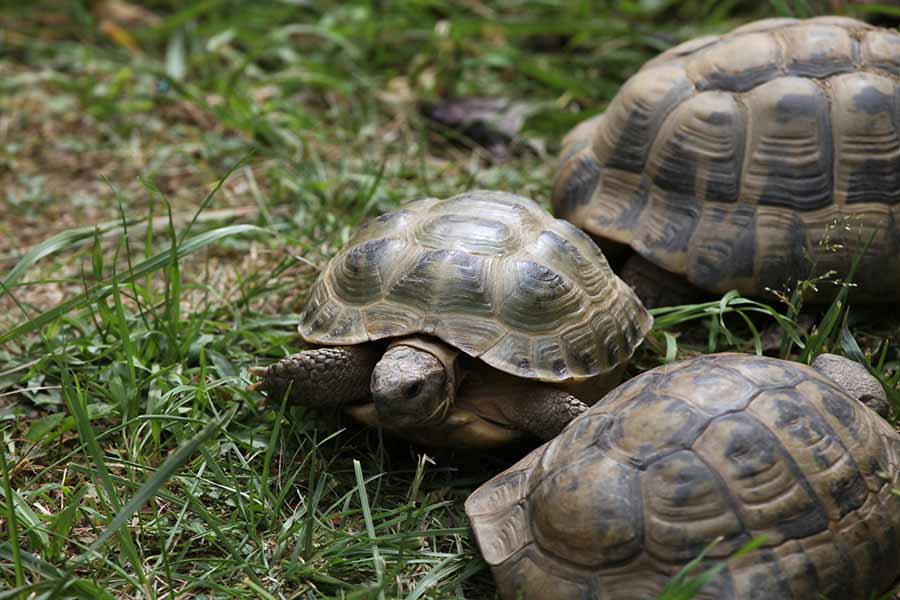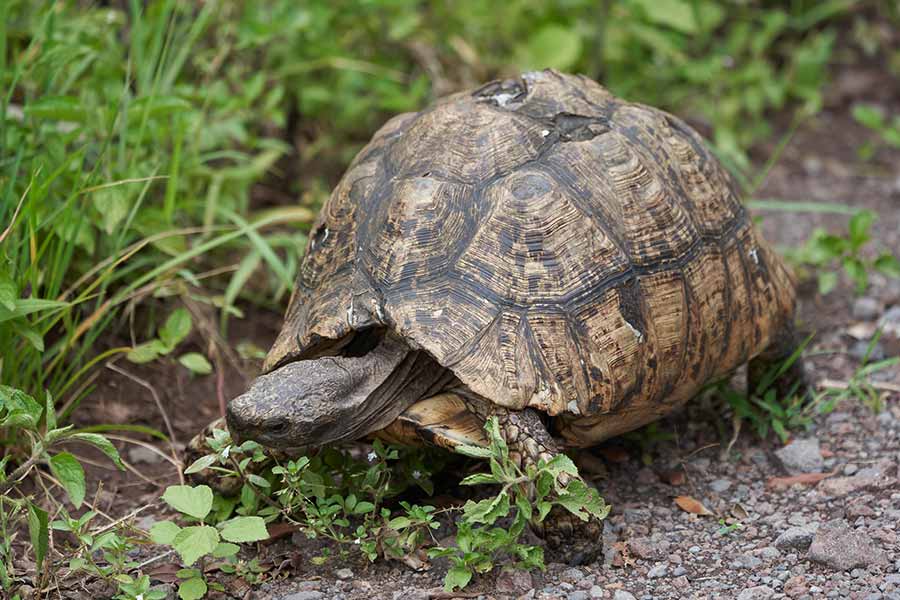Russian tortoise care is fairly simple. They require pretty basic enclosures and can be accommodated indoors as well as outdoors. If you live in the right climate, you can even house your Russian tortoise outdoors in summer and winter in a modified enclosure!
The Russian tortoise is known by a couple of other names depending on where you are in the world. It is also commonly called the Horsefield’s Tortoise, the four-toed tortoise, the Afghan tortoise, the central Asian tortoise, and the Steppe tortoise.
As curious and active creatures, Russian tortoises are fun to own for experienced owners, and their husbandry needs are simple enough that beginners should be able to manage their care as well.
Keep in mind that Russian torts can live for well over 50 years with good care; this means they can be lifelong companions!
Species Information
Where Do Russian Tortoises Come From?
Russian tortoises come from various areas in Asia. They specifically are native to parts of Pakistan, Iran, southern Russian deserts, Afghanistan, and China. These tortoises are often found in mountainous areas in higher elevations.
They are evolved to live in regions that have extreme temperature changes. To handle these fluctuating temperatures in the wild, they must hibernate for seven to nine months out of the year. Luckily, in captivity, Russian tortoises do not need to be hibernated in order to be healthy, which means you get to enjoy your tortoise year-round instead of three to four months of the year.
Unfortunately, these tortoises are commonly caught in the wild, transported in the pet trade to the USA, and are sold as sub-adults or adults. These wild-caught tortoises often suffer from dehydration, malnutrition, parasites, and typically will not live very long lives.
To ethically buy a Russian tortoise, look for reputable breeders. These breeders will sell you Russian tortoises that are healthy and are captive-bred. Therefore, you will not be affecting the animals’ natural population or funding the illegal pet trade.
How Do Russian Tortoises Behave?
Russian tortoises are very active creatures. They love to climb over objects and dig deep burrows to help them adjust to the changing temperatures.
They are very curious tortoises and will explore their enclosure enthusiastically. This means you can have fun decorating their enclosure and changing it up when you clean it.
Because they are such active, curious, and intelligent animals, they need to be mentally stimulated and have adequate space to physically move around to prevent them from getting bored.
What Does a Russian Tortoise Look Like?
Baby or hatchling Russian tortoises start their lives at merely one inch in length. When they mature over the next couple of years, they will grow to five to eight inches. Females are larger than males and may measure up to 10 inches in length. Their compact size makes them ideal tortoises for small gardens or indoor enclosures.
Their skin is a yellow to olive color. When they are younger, they have clearly defined dark brown to black markings on their carapace. As the tortoise gets older, these markings become less defined and fade into smaller splotches.
On the plastron (the underside or belly part of the shell), your tortoise will either have brown to black markings, or the entire plastron will be a solid dark color.
On their feet, Russian torts have four strong claws. This trait gives them one of their other common names: the four-toed tortoise. This is a unique development for these tortoises, and it helps them climb and burrow effectively.
Housing Your Russian Tortoise
Russian tortoises should ideally be housed outside. However, if the weather in your area does not allow for that, then they can also be housed inside quite comfortably.
Alternatively, if your area is warm and stable enough in summer but too cold in winter, then you can either allow them to burrow and hibernate outside in the colder months or bring them inside and maintain stable, warm temperatures for them.
In general, bringing them inside is a safer bet if you are new to tortoise care and not sure how to handle hibernation at first.
Enclosure Size
Your Russian tortoise should have an enclosure that is at least two feet wide by four feet long. The sides of the enclosure must be at least 12 to 16 inches above ground and 6 to 12 inches below ground to accommodate the tortoise’s desire for both climbing and digging.
Russian tortoises love to climb, and they will take any opportunity to climb over any enclosure walls that are too short. Your tortoise should also not be able to see through the sides of the enclosure. This encourages them to try and escape and can cause them serious stress.
Not only do these torts love to climb, but they also love to burrow. If temperature conditions are less than ideal, then your tortoise will burrow more than normal. They use these burrows to cool down in warmer weather and warm up during cold weather. If you allow your tortoise to hibernate, they will do so in their burrow.
To avoid them burrowing under the sides of the enclosure and escaping, place large rocks under the soil along the border to discourage them from burrowing further.
If you house your tortoise inside, then they need a suitably sized enclosure. A Russian tortoise that is housed in a small tub or tortoise table would not be able to move around and get exercise both physically as well as mentally.
If you see your tortoise constantly trying to escape its indoor enclosure, then the chances are it is too small, and your pet is likely suffering from stress and boredom.
Humidity
Russian tortoises like it dry. They do not need to be misted or soaked regularly. These tortoises are adapted to arid desert climates. If they are subjected to high humidity levels, they can quickly develop respiratory and fungal infections.
If you provide your tortoise with a bath for it to occasionally soak in, then it will decide when it needs water and when it needs to dry out. Don’t force your tort to soak or bathe.
Temperature and Heating
Part of the reason why Russian tortoises are such popular pets is that they can tolerate a wide range of temperatures. Nighttime or winter daytime temperatures should not drop below 65°F to 70°F.
During the day, they should be able to warm up in their basking spots whenever they feel like it. Whether your tortoise is housed indoors or outdoors, they will need free access to a warm basking spot. If they cannot achieve this via natural sunlight, then they need access to an artificial source of heat. As with most pet reptiles, you can easily accomplish this with a simple domed
If you house your tortoise outdoors and you need an additional source of heat, then building them a small hot hide will help prevent them from burrowing looking for heat and will keep them nice and warm. A small dog house, for example, makes a perfect tortoise hide.
Your tortoise should be able to move freely between the warm and cool areas of its enclosure so it can thermoregulate properly.
UVB Lighting
Russian tortoises need a photocycle of 12 to 14 hours of light and the rest dark. During these dark hours, all sources of light should be shut off, even if they are red bulbs or heating elements. Any light during their dark cycle will disrupt their natural cycle and cause them unnecessary stress.
It is also important for your tortoise to have access to UVB light throughout the light portion of their photocycle. UVB light is essential for the proper absorption of
If you have moved your Russian tortoise inside during the winter, do not forget to set up their UVB lights.
Keep in mind the UVB will run out much faster than the actual light in the bulb, and the lack of UVB can be difficult to detect. Therefore, you will need to replace your UVB bulb every four to six months depending on its lifespan, even if the light itself hasn’t burned out yet.
Substrate
Your Russian tortoise should have access to a dry substrate. Since these torts are much better suited to dry conditions, they will develop fungal or even respiratory infections due to increased humidity if they are constantly in contact with wet substrate.
A mixture of different sands and regular garden soil will work well. You can have some grassy patches in your tortoise’s enclosure; however, they do not really eat grass if they can help it.
The sand should not be so soft that their feet sink into it and they cannot walk steadily or quickly. However, it should also not be so dense that they cannot burrow, as this will also stress them out.
If they are housed indoors, you can keep Russian tortoises on Timothy hay pellets, dry hay, or other dry substrates such as coconut coir/husk/fiber.
Accessories
Your Russian tortoise should have an interesting and enriching enclosure. They are curious and intelligent animals and will explore their home with delight!
The decorations in your enclosure are more than just for show; they help your tortoise in many ways.
Flat or slightly sloped rocks, for example, will help your tortoise file down its nails. These flat rocks can also serve as plates for their food. Their food should never be placed directly on the soil, as your tortoise may eat the substrate by accident and risk developing impaction. The rocks should not be steep or high enough that your tortoise will flip itself onto its back if it falls off.
You can also include things like logs, halved pipes, and hollowed rocks or upturned plastic tubs as little hideaways for your tortoise to retreat to if they feel stressed.
Colorful objects will attract your tortoise’s attention, and they may push them around for fun. Colorful toys like balls are a favorite. Just make sure nothing is small enough that it can be eaten, as this will cause damage to your tortoise’s digestive tract.
Water Sources and Baths
Your Russian tortoise should always have access to a shallow bath. This pool should be a dish that is flat on the ground, has a lip that is low enough that your tortoise can get into and out of the bath easily, and is nonporous.
Your tortoise will take a bath when it feels the need to rehydrate itself. The bath will need to be cleaned out after every use, as they very quickly dirty the water when they get into it.
The bath is where your tortoise will also do most of its drinking. Like many reptiles, when they are in the water, they tend to do a full system flush by drinking a lot of water and then pooping. To prevent bacterial infections, don’t allow your tortoise to get back into the water after they’ve dirtied it.
Feeding Your Russian Tortoise
Russian tortoises are herbivores. They should never be given animal or insect protein!
As we touched on earlier, these tortoises don’t really eat grass. However, they do love dark green leaves, and they will occasionally munch on weeds they come across. If you house your tortoise outdoors for any length of time, be sure to keep any unsafe or toxic plants far out of their reach.
Each day, your tortoise should eat a salad of various dark greens and weeds roughly the same size of their shell. That means even a small tortoise can eat a surprisingly large amount!
The following foods are all great options for your tort:
- Kale
- Dandelion greens and flowers
- Escarole
- Endive
- Lamb’s lettuce
- Beet tops
- Collard Greens
- Mustard greens
Two to three times a week, be sure to sprinkle some
Common Health Problems
Parasites
As many of the Russian tortoises you may come across are wild-caught and exported to the USA, they will have high parasite loads. In the wild, the tortoises can usually function with these parasites.
However, in captivity, they cannot live with the parasites, and they will become steadily sicker and sicker and have a much-shortened life span.
Take a stool sample to your exotic vet to get it tested for a parasite infestation if you are unsure of your tortoise’s origins.
Calcium Deficiency
Russian tortoises, like all reptiles, need a healthy source of
However, they will still need a
It’s a good idea to always check the
Calcium deficiency results in malformed shells and metabolic bone disease.
FAQs About Russian Tortoise Care
Will my Russian tortoise eat my bunny if I leave it in the garden?
Russian tortoises are herbivores and will not eat other animals. However, they should not be left unattended with other animals they are unfamiliar with. This is because both animals can get stressed out and hurt.
Are Russian tortoises hard to care for?
Russian torts are not particularly hard to care for; in fact, they are good candidates for first-time tortoise owners!
Does my Russian tortoise need a friend?
Russian tortoises do not necessarily need company, though they will do well with one or two companions of the same size in the same enclosure if you can properly accommodate them. Every time you add a tortoise to the enclosure, you will need to extend the enclosure by a square foot.
Slowly Strolling Off…
Russian tortoise care is relatively simple once you get the basics set up!
Their indoor or outdoor enclosures are not terribly large and will not take up a lot of space. These enclosures will also be pleasing to look at because they will be filled with interesting decorations for your tortoise to climb in, on, and under!
These lifelong pets are very rewarding because of their active and curious nature. Good luck on your new adventure with your scaly companion!
If you want to learn about other tortoise species, check out this article.




